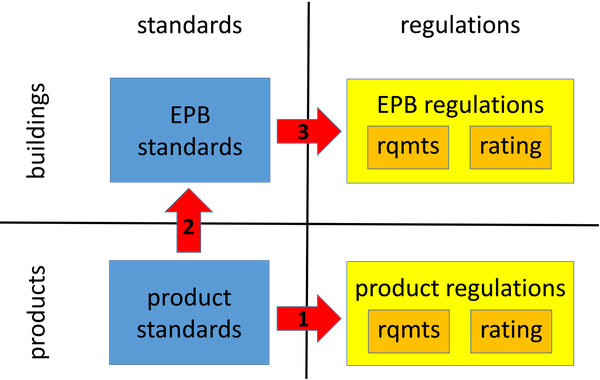Products And Product Standards
Link between the product standards & the EPB standards
The materials and products that are used in a building determine to a significant extent its energy consumption. In order to assess the overall energy performance of a building, the relevant product characteristics must therefore be known: specific energy properties of the products serve as (part of the) input for the overall EPB calculation. In the beginning of each EPB standard, all required (product and other) input variables are explicitly listed in tables.
As a general rule, the quantitative product properties are determined according to standardized methods by (a combination of) testing and/or calculation, as specified in a univocal manner in the product standards.
Both the product standards and the EPB standards provide input to the corresponding product and building regulations, which (among others) define requirements and ratings/labels. This corresponds to arrows 1 and 3 respectively in the following simplified schematic, which shows the information flows between these different domains.

The basic, intrinsic product properties that are used in the product regulations (arrow 1) and those used in the EPB assessment methods (arrow 2) are not necessarily (all) the same. Also, the evaluation methodologies of the basic product data in each of these 2 applications may differ: in the EPB, specific boundary conditions of the individual building at hand can be taken into account; in the product regulations typical, more average boundary conditions need to be applied.
Figure 4 in clause 6 of CEN ISO/TR 52003-2:2017 describes in more detail the different relations of this simplified schematic. This Figure 4 was also presented orally in a webinar (minutes 12:18-18:35 into the presentation, with a focus on the product standards starting at minute 17:35).
The product standards thus constitute an essential foundation for the EPB standards (and for the product regulations). It is self-evident that they all must be well adjusted to one another. The product standards need to define all product properties necessary for a robust EPB assessment of a building (and for the product regulations).
EU energy efficient product policy
In the European Union the energy efficiency of products or kits is regulated by:
- The Ecodesign Directive, which sets energy requirements. These are regularly tightened (typically every 5 years).
- The Energy Labelling Regulation (ELR), which imposes labels.
Both regulations also establish mandatory product information sheets.
More information on this Energy Efficiency product policy is available on the website of the European Commission.
In execution of the ELR, a public database of all labelled products (EPREL) is under development (state mid 2020).
Possible further developments
There remain still potential further synergies between EPB and product standards & policies. Future opportunities include, amongst others:
- As needs would arise, in the product standards extra testing points can be defined, which would be necessary for an adequate assessment of the performance of the (new) product as used in a specific building. (Obviously, in the same go any remaining needs from the product regulations with respect to the same product standard(s) can be fulfilled as well.)
- Maybe for more products than is the case now, common assessment methods (but with different boundary conditions, as explained above) can be used in the evaluations of the overall EPB and in the evaluations in the product regulations.
- All the original, basic product properties that are required as input for the EPB calculations can be included as such in the information sheets that are imposed by the Ecodesign Directive and/or ELR. This allows for a ready "manual" retrieval of the data from the sheet, and manual input in an EPB calculation programme.
- The EPREL database could in a 2nd phase be extended to include for all EPB products on the EU market all property values necessary for the EPB assessment (in electronically accessible format, so that readily importable in an EPB software programme at a single click of the mouse).
An oral explanation of 3 of these potentials in relation to the overview graph was given during the Q&A part of the webinar, minutes 1:19:20-1:25:10.
(updated August 10, 2020)
Highlight on heat pump systems
See the page on the EPB standard on heat pump systems for specific information on harmonization of ErP/EPBD related Heat pump standards EN 14825 / EN 15316-4-2.
Comments?
Comments, questions or suggestions? Feel free to get in touch!
